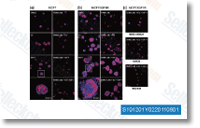In addition, our study shows that FLSs isolated from RA synovium also make chemerin in vitro and that this production is upregulated by stimulation with TNF a and IFN g, which characterize the inflammatory environment inside the RA synovium. In this regard, it was reported that the concentration of chemerin inside the synovial fluid was substantially greater in RA than that in OA. ChemR23 was expressed on most macro phages, CD1a immature DCs and FLSs in RA syno vium. A number of DC LAMP mature DCs also expressed ChemR23. It was previously reported that ChemR23 was expressed on immature DCs derived from peripheral blood and that the expression was downregulated by maturation induced by lipopolysaccharide or CD40L. The exclusive pathway of activation on the chemerin precursor, prochemerin, has been effectively investigated.
Prochemerin is deemed to be activated via C terminal six or seven amino acid processing by protease and to become produced by neutrophils and mast cells at inflammatory sites. Neutrophils and mast cells are recognized to release protease wealthy granules and to secrete immune mediators to activate order inhibitor themselves along with other immune cells, triggering good regulatory feedback that results in acute or chronic RA inflammation. Regarded as together, our selleckchem information suggest that che merin is created at higher levels by FLSs in RA syno vium and that extracellular protease is created by preexistent neutrophils and mast cells converted from inactive prochemerin into bioactive chemerin, which have effective chemoattractant properties for migration of macrophages and DCs in to the RA synovium.
The present benefits reveal that the expression of ChemR23 on RA FLSs and chemerin itself activate FLSs to improve the production of IL six and CCL2. IL 6 is considered to possess  pleiotropic functions, including the regulation of maturation and activation of T and B cells, macrophages, osteoclasts, chondrocytes and endothelial cells in RA. Clinically, tocilizumab, a humanized mAb specific for IL 6R, has outstanding anti inflamma tory effects, which includes suppression of disease activity and erosive progression in individuals with RA that’s resistant to conventional illness modifying antirheumatic drugs. CCL2 is referred to as a prototype chemokine that attracts monocytes, T cells, NK cells and basophils in to the RA synovium. As a result, our benefits indicate that chemerin may well be involved in the enhancement of neighborhood proinflammatory cytokine and chemokine produc tion by RA FLSs, leading to persistent amplification of inflammation inside the RA synovium, possibly in an auto crine or paracrine manner. The present benefits indicate that chemerin enhances the cell motility of RA FLSs, whereas CCL2 does not promote FLS migration by this examination process.
pleiotropic functions, including the regulation of maturation and activation of T and B cells, macrophages, osteoclasts, chondrocytes and endothelial cells in RA. Clinically, tocilizumab, a humanized mAb specific for IL 6R, has outstanding anti inflamma tory effects, which includes suppression of disease activity and erosive progression in individuals with RA that’s resistant to conventional illness modifying antirheumatic drugs. CCL2 is referred to as a prototype chemokine that attracts monocytes, T cells, NK cells and basophils in to the RA synovium. As a result, our benefits indicate that chemerin may well be involved in the enhancement of neighborhood proinflammatory cytokine and chemokine produc tion by RA FLSs, leading to persistent amplification of inflammation inside the RA synovium, possibly in an auto crine or paracrine manner. The present benefits indicate that chemerin enhances the cell motility of RA FLSs, whereas CCL2 does not promote FLS migration by this examination process.
DUB Signal
Specific genes that can be activated by inducers are called inducible genes.
